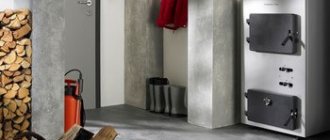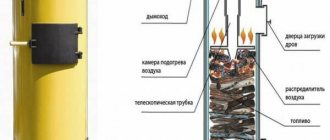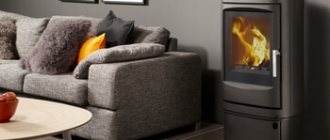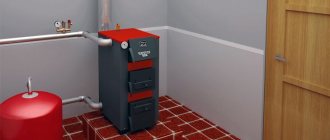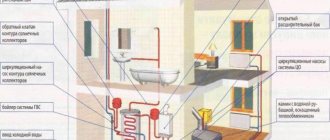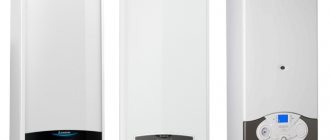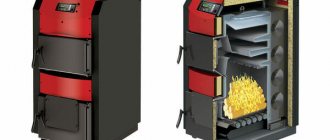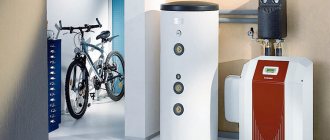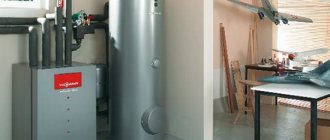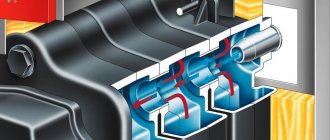To provide warmth in your home or country house, your own autonomous heating system is installed all year round. A long-burning solid fuel boiler (TCDG) can be an effective source of thermal energy . It is capable of operating for a long time on one load of fuel, which is facilitated by special technology.
Such equipment from leading domestic and foreign manufacturers is widely represented on the Russian market.
The question of how to choose the optimal model deserves special attention.
Rating of the TOP 10 best long-burning solid fuel boilers for 2021-2022
Long-burning solid fuel boilers are becoming indispensable in regions where there is no need to think about natural gas yet. They have proven to be very effective.
You can choose a model for a specific fuel type or choose a universal model. When choosing, you should take into account the main criteria.
The rating of the best models allows you to choose the best option.
| Place | Name | Price |
| TOP 5 best long-burning solid fuel boilers with a water circuit | ||
| 1 | Stropuva S30 30 kV | Find out the price |
| 2 | Stropuva Mini S8 8 kW | Find out the price |
| 3 | Teplodar Cooper Expert 15 | Find out the price |
| 4 | Teplodar Cooper Expert 22 | Find out the price |
| 5 | ZOTA Carbon 50 | Find out the price |
| TOP 5 best long-burning solid fuel boilers without a water circuit | ||
| 1 | Teplodar Cooper Expert-45 | Find out the price |
| 2 | TermoKRoss TKR-08D | Find out the price |
| 3 | Aremikas Candle 35 kW | Find out the price |
| 4 | Stropuva S40 40 kW | Find out the price |
| 5 | Stropuva S15 15 kW | Find out the price |
Distinctive features
A long-burning double-circuit boiler operating on solid fuel is a modernized version of classic heating equipment.
It, among other things, also has a heat exchanger built into it, providing the home with a full-fledged hot water supply.
The design of the two-circuit model includes the following elements:
- Housing - can be made of sheet steel or cast iron. The thickness of the metal ranges from 4 to 6 mm.
- Fire chamber . Usually made from the same material as the body of the device.
- Grate type grate . It is located inside the combustion chamber; the material is cast iron. Enriches the fuel with the oxygen necessary to support combustion.
- Ash pan . Accumulates solid waste generated during combustion.
- Chimney - removes combustion products outside the room.
- "Water Shirt" . Most often it is built into the boiler body and filled with water, which receives heat from the walls, after which it enters the heating system.
- Additional heat exchanger coil - distinguishes double-circuit models from single-circuit ones. It is built into the water jacket of heating equipment to provide hot water supply to the house.
The main disadvantage of this design is the low degree of productivity . Therefore, models made of cast iron are more popular because they take longer to cool down.
What to look for when choosing?
When choosing a TKDG, the main attention should be paid to the following characteristics:
- Type of fuel . The units can be designed for a specific fuel or be universal. Main options: coal, firewood, peat, pellets.
- Boiler power . It determines the heated area. For domestic needs, usually does not exceed 100 kW.
- Number of circuits : single-circuit or double-circuit.
- Loading chamber volume . The duration of operation without new fuel loading depends on it.
- Cost-effectiveness , i.e. fuel consumption. The main indicator is efficiency.
- Durability or service life.
- Control systems : electronic or mechanical.
- Safety . Critical protection systems must be provided.
- Price.
You should also pay attention to the material of the body and combustion chamber, loading method (manual, automatic, semi-automatic), volatility, weight and dimensions.
Fuel requirements
Although such long-lasting boilers can be heated with wood or wood pellets, the duration of their combustion will not be 7 days, but depending on the characteristics of the fuel – 12-30 hours. High-quality pellets can provide heat generation for a maximum of 72 hours, i.e. up to 3 days.
To ensure a combustion duration of up to 7 days, it is necessary to use coal. The optimal price-quality ratio is coal. Anthracite has the greatest heat transfer, but the cost of such coal is 8000-8500 rubles. per ton, which is not cheap. Charcoal (especially from hard wood - grade A) also has excellent heat transfer and burning duration.
The worst option is the common and most affordable brown coal, which burns in 3-4 days at best and has a much higher ash content compared to other varieties.
In addition, it is better to burn with low-caking (type 31 or 32) and low-ash (up to 15%) coal to avoid the appearance of excess “garbage” and a decrease in efficiency.
Pellet boilers with automatic fuel supply Burning duration from 7 to 30 days thanks to the storage bunker
The best solid fuel boilers with a water circuit
Based on consumer reviews and expert opinions, we have compiled a rating of TKDGs from different manufacturers.
Below is the TOP 5 best models with a water circuit.
Stropuva S30 30 kV
Among the best models, TKDG Stropuva S30 stands out. The unit is capable of heating a room with an area of 200-300 m2.
Firewood and pellets are used as fuel. Combustion occurs according to the “top-down” principle. The boiler does not require electrical power. Traction is provided by a special bimetallic regulator. Mechanical control.
The heat exchanger is made of stainless steel. Has a floor-standing design. Despite its considerable dimensions, the boiler has an ergonomic design. An air distributor for firewood and pellets is provided.
There is a valve for maintaining pressure up to 2 bar.
Specifications:
- thermal power - 30 kW;
- fuel capacity – 342 dm3;
- burning time on one tab – 31 hours;
- volume of water in the boiler – 51 l;
- Efficiency – no less than 85%;
- water temperature – 75 degrees;
- dimensions – diameter – 68 cm, height – 185 cm.
- weight – 280 kg.
pros
- simplicity of design and control;
- affordable price;
- long burning on one tab;
- energy independence.
Minuses
- not designed for coal;
- mechanical control;
- no display.
In the budget category, this model especially stands out for its reliability and durability.
Stropuva Mini S8 8 kW
The Stropuva boiler line is adequately represented by the Stropuva Mini S8 model. The device is designed for heating
rooms up to 80 m2.
Fuel - firewood and wood briquettes.
It consists of 2 cylindrical chambers made of stainless steel. Top combustion of fuel is ensured. Air is supplied to the firebox through a telescopic pipe. Automatic adjustment of its supply is provided. The boiler maintains a cyclic operating mode. Mechanical control.
Fuel loading is manual. The water temperature is changed by a bi-thermal draft regulator. The control is based on a very simple design but reliable automatic valve. Installation - floor.
Specifications:
- thermal power 8 kW;
- burning time on one stack is 30 hours (48 hours on briquettes);
- Efficiency – no less than 85%;
- water temperature – up to 90 degrees;
- dimensions – diameter – 55.5 cm, height – 136.5 cm.
- weight – 145 kg.
pros
- small dimensions;
- European quality certificate;
- optimal heat removal;
- energy independence.
Minuses
- the rough surface of the body makes cleaning difficult;
- Difficulty loading.
This model is ideal for small houses and cottages, as noted by most consumers.
Teplodar Cooper Expert 15
Teplodar Kupper Expert 15 is a Russian-made heating TKDG, designed for premises
area 100-150 m2.
Firewood, briquettes and coal can be used as fuel.
The design additionally includes a built-in heating element to maintain the coolant temperature. There are 4 operating modes: fast warm-up, Classic, Medium and Maximum. For ease of maintenance there are 2 cleaning hatches. Combustion is ensured from top to bottom.
The fuel loading door is protected by a stainless steel screen. Heat exchanger material – stainless steel. Control is mechanical. Installation - floor.
Specifications:
- thermal power - 15 kW;
- burning time on one tab – 24 hours;
- Efficiency – 90%;
- water temperature –60-95 degrees;
- dimensions – 51.3x88x77.5 cm;
- weight – 148 kg.
pros
- different operating modes;
- adjustable coolant temperature over a wide range;
- convenient cleaning;
- affordable price.
Minuses
- lack of built-in expansion tank;
- energy dependence when using heating elements.
The model is popular because combines price and reliability well.
Teplodar Cooper Expert 22
The Kupper series is represented by the high-power TKDG Teplodar Kuppe Expert-22. The boiler is capable
heat a house up to 220 m2.
Structurally, the model is largely similar to the previous device. To maintain the temperature, a 6 kW heating element is installed. The long process is ensured by top combustion.
Efficiency is increased due to a developed heat exchanger and 3-zone air supply. You can set 4 different operating modes. You can lay coal, firewood, pellets. The chimney carries combustion products back. Control is mechanical. Installed on the floor.
Technical specifications:
- thermal power - 22 kW;
- firebox volume – 45 l;
- burning time on one tab – 31 hours;
- volume of water in the boiler – 90 l;
- Efficiency – 90%;
- water temperature – up to 95 degrees;
- dimensions – 51.3x88x88.3.
- weight – 165.5 kg.
pros
- possibility of quick heating;
- large area of the heated house;
- availability of economy mode;
- Ease of Management.
Minuses
- energy dependence;
- mechanical control;
- lack of a built-in pump.
Widespread use for heating large houses is explained by its affordable price and high quality.
ZOTA Carbon 50
One of the best TKDG is the ZOTA Carbon 50 model, which can heat houses and industrial
premises with an area of more than 400 m2.
The unit is designed for coal fraction 10-50 mm.
A special air supply control system ensures long-lasting fuel combustion. The body is made of high-strength boiler steel. Top coal loading and a three-pass gas duct are provided.
You can additionally install a heating element to maintain the temperature during fuel combustion. The kit includes an adjustable chimney pipe. The ash pan is located on the cooled surface. The movable grate makes cleaning easier.
Specifications:
- thermal power - 50 kW;
- fuel capacity – 87 dm3;
- burning time on one tab – 30 hours;
- volume of water in the boiler – 102 l;
- water temperature – 90 degrees;
- dimensions – 91.5x69.5x117 cm;
- weight – 303 kg.
pros
- high-strength body;
- large combustion chamber;
- convenient cleaning;
- high thermal power;
- high working pressure.
Minuses
- lack of a built-in pump;
- increased price.
Consumers note that the high cost of the unit is consistent with its power and reliability.
Correct installation of the boiler: step-by-step instructions
Many consumers, purchasing a solid fuel boiler and expecting from it the effect of long-term and economical burning of raw materials up to the stated up to 7 days, after some time pay attention to the fact that the device does not provide the declared efficiency. And the point here is not at all the poor quality or defective boiler, but the mistakes made during connection.
Do-it-yourself TT boiler installation
Of course, given the complexity of the design and the responsibility of this event, many entrust the installation of a long-burning TT boiler to craftsmen. However, following our detailed step-by-step instructions, you can install the boiler yourself, without outside help. Although you can’t do this without an assistant, because the device weighs at least 50 kg.
At the stage of preparatory work, you should immediately think about where the boiler will be installed. Ideally, of course, to equip a separate boiler room.
boiler room in a private house
Considering that solid fuel does create some dirt, such a heating system should be installed in a separate non-residential building. But if the boiler power is small (does not exceed 30-35 kW), then you can simply separate (zone) the main room from the “boiler room”.
Ventilation diagram in the boiler room
To ensure that people servicing boilers and igniting them do not have breathing problems, the boiler room must be equipped with a ventilation system. Clean air must come from the street.
Prepare the following tools:
- Locksmith set (adjustable, open-end, ring wrenches).
- Building level.
- Circular Saw.
- Screwdriver and set of bits.
- Marker.
- Caulk gun.
Locksmith tool set
In addition to the solid fuel heating boiler itself, you will also need to purchase materials to connect the boiler to the heating system.
- Steel coupling (3 pieces).
- Ball valve with drive (2 pcs) with a diameter of 50 mm.
- Metal pipe for connecting the boiler.
- Sealant (fireproof).
- Plumbing winding.
Stage 1. Preparing and protecting the premises.
The issue of fire safety should be approached with all responsibility.
- We decide on the place where the boiler will be located. If an outdated model is being replaced in a house with a more modern and efficient one, then the place along with the chimney has already been prepared. If the heating system is designed from scratch, then you should immediately consider the gas exhaust system and the location of the boiler in the room. The location for installing the boiler should provide convenient operation and direct access. The room where the solid fuel boiler is installed must be non-residential.
Boiler location
- The base on which the boiler will be placed must be covered with a metal shield. In this case, the dimensions of the shield should be 25% larger than the device itself. If the power of the device exceeds 50 kW, then such a unit should be installed on a concrete screed foundation. As a rule, the height of such a foundation should be 100-150 mm above the floor level. In this case, the foundation must have a screed separate from the floor.
Installing the boiler on a metal sheet
When installing a low-power unit, it is allowed to install the boiler on a rough concrete screed.
Be sure to check the level of the foundation slope. It should be perfectly smooth. If necessary (if the floor is not level), a brick foundation should be laid.
- Draw a marker or chalk on the floor where you will install the boiler and carefully double-check all distances. Maintain distance from walls (regulated by SNiP). The distance from the combustion door to the wall must be at least 125 cm. The distance between the side parts and the back of the boiler and the wall must be at least 700 mm.
- Apply a layer of plaster 25 mm thick to the wall adjacent to the front of the boiler (where the firebox and door are located). Additionally, we install a metal sheet at a level 25-30 cm above the boiler.
Protecting the wall behind the boiler
- Remove the new boiler from its original packaging.
- Place the boiler on the prepared foundation and again check with a level how level the device is. The gas outlet pipe should be at the same level as the chimney pipe. If the line is not smooth, traction may be disrupted during operation.
- Insert all the necessary boiler elements supplied separately (ash pan, doors).
Fire safety standards
The best solid fuel boilers without a water circuit
Below is the TOP 5 TKDG models without a water circuit, especially distinguished by their quality and reliability.
Teplodar Cooper Expert-45
The top five TKDG includes the Teplodar Kupper Expert-45 model, capable of heating a room of
200-450 m2.
The boiler can operate on almost any type of solid fuel.
Heat exchangers and grates have a large contact area with heated gases, which increases the efficiency of heat removal. Operation can be provided in 4 modes, incl. on economical and maximum.
The tilting door and special tray make loading easier. The fast heating mode allows you to heat the coolant in 30 minutes. A simple but reliable draft regulator is provided. There is a built-in heating element. Installation method: floor.
Specifications:
- thermal power - 45 kW;
- burning time on one tab – 24 hours;
- Efficiency – at least 75%;
- water temperature – 95 degrees;
- dimensions – 103x65x81.5 cm;
- weight – 207 kg.
pros
- increased power;
- the presence of a mode of increased combustion duration;
- economical fuel consumption;
- ability to work on any solid fuel.
Minuses
- mechanical control;
- energy dependence when installing heating elements;
- lack of built-in expansion tank.
The boiler is designed for large houses, and under these conditions it shows itself to be very effective.
TermoKRoss TKR-08D
The TermoKRoss TKR-08D boiler receives many positive ratings. This is a single-circuit type unit with a firebox
closed type. Combustion occurs from top to bottom.
It can heat a room up to 80 m2. Air is supplied through a special valve directly into the combustion zone. Designed to work on firewood and wood briquettes, coal and pellets.
Mechanical control. The heat exchanger is made of stainless steel. You can additionally install a heating element to maintain the temperature when the wood burns. The chimney diameter is 160 mm. Overheating protection is provided.
Specifications:
- thermal power - 8 kW;
- burning time on one stack of wood – 35 hours, coal – 170 hours;
- volume of water in the boiler – 38 l;
- Efficiency – 91%;
- water temperature – 95 degrees;
- dimensions – diameter – 56 cm, height – 140 cm.
- weight – 175 kg.
pros
- compactness;
- simplicity of design and control;
- increased operating time on one load;
- energy independence in the absence of heating elements.
Minuses
- mechanical control;
- reduced power.
The boiler is fully adapted to Russian conditions and has an affordable price.
Aremikas Candle 35 kW
Among the leaders stands out the solid fuel single-circuit boiler Aremikas Candle 35 kW, designed for
heating a house with an area of up to 300-350 m2.
It has a floor-standing design. When burned, only the surface layer of fuel up to 20 cm thick burns. Firewood and wood briquettes are used as fuel. Mechanical control.
The firebox has a cylindrical shape. The heat exchanger is made of stainless steel. There is an automatic draft regulator that allows you to change the temperature of the coolant.
Specifications:
- thermal power - 35 kW;
- fuel capacity – 400 dm3;
- burning time on one tab – 34 hours;
- Efficiency – at least 80%;
- water temperature – 90 degrees;
- dimensions – diameter – 70 cm, height – 207 cm.
- weight – 315 kg.
pros
- significant thermal power;
- possibility of connecting a boiler;
- large firebox volume;
- economical fuel consumption.
Minuses
- the use of coal is not provided;
- significant weight;
- increased cost.
The boiler allows you to heat large volumes of premises, which compensates for the high price.
Stropuva S40 40 kW
The Stropuva S40 40 kW model is noted among the leaders of high-power TKDG. The unit has one circuit and can
heat an area up to 400 m2.
You can connect an external water heater.
An open combustion chamber is used. Firewood is recommended as fuel. Mechanical control. Floor installation in a separate room. The heat exchanger is made of stainless steel.
Protection is provided by a safety valve. There is a special device for air distribution. The maximum water pressure in the circuit is 1.5 bar. A chimney with a diameter of 200 mm is provided.
Specifications:
- thermal power - 40 kW;
- burning time on one tab – 31 hours;
- Efficiency – 92%;
- water temperature – 60-95 degrees;
- dimensions – diameter – 68 cm, height – 212 cm.
- weight – 291 kg.
pros
- simplicity of design and maintenance;
- significant power;
- Possibility of cascade connection;
- complete safety.
Minuses
- lack of expansion tank;
- significant height of the unit;
- increased cost.
Great possibilities for heating huge houses compensate for all the shortcomings.
Stropuva S15 15 kW
One of the best representatives of the Stropuva family is the single-circuit solid fuel boiler Stropuva
S15.
It copes with heating rooms up to 150 m2.
The design includes 2 steel cylinders that fit inside each other, with external thermal insulation. The heated coolant is directed into the space between the cylinders. Air is supplied through a telescopic pipe. Fuel – firewood and wood briquettes.
Installation - floor. The parameters are regulated by a bithermal draft regulator. Mechanical control. No electricity required to operate. The safety valve ensures complete safety.
Specifications:
- thermal power - 15 kW;
- burning time on one stack is 30 hours (48 hours on briquettes);
- Efficiency – no less than 85%;
- water temperature – 90 degrees;
- dimensions – diameter – 56 cm, height – 172 cm.
- weight – 200 kg.
pros
- compactness;
- high reliability and safety;
- energy independence;
- economical fuel consumption.
Minuses
- reduced power;
- lack of expansion tank and built-in pump.
The boiler is designed for heating relatively small rooms where large thermal output is not required.
Tips for choosing
Before choosing a boiler, you need to calculate the required power, based on the area of the room, the presence of insulation, the height and thickness of the walls. The selection of the burning time for one bookmark also depends on these parameters.
Most devices use the following types of fuel:
- briquettes;
- coal;
- pellets;
- peat;
- wood;
- oil shale.
You should also decide on the type of fuel in advance, giving preference to a more affordable option.
The material from which the heat exchanger is made is also important. Cast iron products have a sectional structure and are of high quality, but are poorly protected from thermal shock. Steel models are produced in the form of monoblocks. They withstand thermal shock better, but are difficult to transport and repair.
The cost-effectiveness of operating a unit is determined by the totality of service costs, suitability for repair and efficiency indicator.
When choosing a heating device, you should correctly compare its functionality and the size of the room so as not to overpay for excess power. It is better to give preference to models from trusted manufacturers that use affordable fuel.
Operating principle of TKDG
Long-term combustion in a TKDG furnace can be ensured in 2 ways:
- Top combustion principle . In the combustion chamber, the fuel does not burn, but smolders with limited access to oxygen. The cylindrical firebox is located at the top of the unit and has a cylindrical shape. The gas released during smoldering enters the afterburning chamber, where a supply of atmospheric oxygen is ensured for its complete combustion. As a result, almost complete combustion of the fuel occurs with the active release of thermal energy.
- Pyrolysis principle . The combustion chamber is located at the bottom. Active smoldering of fuel also occurs here with limited access to oxygen. The combustible gas rises up and reaches the second chamber, where, enriched with oxygen, it burns completely.
Thus, the duration of combustion is ensured by the two-chamber design of the unit, when the fuel slowly smolderes in the firebox, and the released combustible gases burn in the second chamber.
Types of devices
According to the method of fuel combustion, long-burning boilers with a double circuit can be divided into:
- Pyrolysis . Equipped with two combustion chambers. In one of them, the process of smoldering and the release of gas for pyrolysis occurs, in the other, the resulting gas is mixed with oxygen and burned. Equipment of this type is characterized by high environmental friendliness - a minimal amount of harmful substances is released into the atmosphere. The combustion process produces little soot. If the boiler is equipped with automation, power adjustment will be possible.
- With upper combustion chamber . Such boilers are very easy to maintain. The amount of automation required for their stable operation is minimal; it is possible to operate in autonomous mode without electricity. There are also disadvantages - a lot of ash is generated during operation, there is a list of requirements for fuel types. For example, small wood chips or sawdust are not suitable for kindling.
- Pellet . To kindle such equipment, special pellets or compressed fuel briquettes are used. Such boilers are environmentally friendly, economical and efficient, and have a long service life. One of the main disadvantages is the high price of the boiler and the special conditions that will have to be maintained for fuel storage. The room should be dry; high air humidity will contribute to the deterioration of pellets.
Advantages and disadvantages
Advantages of the boilers under consideration:
- high efficiency exceeding 90%;
- accessible and fairly cheap fuel;
- ease of installation, management and operation;
- almost complete combustion of combustion products;
- increased durability;
- affordable price.
Some disadvantages of TKDG should also be noted:
- the need for a separate room for installation;
- the need for periodic ash removal;
- arrangement of a storage facility for fuel supplies.
In budget designs, fuel is loaded manually, which can also be attributed to the disadvantages of such equipment.
Conclusions and useful video on the topic
Tips for choosing boilers for your home:
Boilers that maintain combustion for a long time are an excellent alternative to units that run on increasingly expensive fuel..
Yes, they cannot boast of compactness or ease of use. But equipment of this class is highly efficient, which allows you to save your time and a significant amount of money. But only if the heating system is properly designed.
Share your opinion on the operation of boilers and useful information not mentioned in the article. It is possible that you have valuable information at your disposal that will be useful to site visitors. Please leave comments, ask questions, and post photos in the block below.
Water circuit
To ensure autonomous hot water supply, in addition to the heating system, TKDG with a water circuit or double-circuit boilers are installed. Such units have 2 independent circuits for water circulation. An additional heat exchanger acts as a boiler and is intended only for heating water.
If the TKDG is connected to the water supply network, then water circulation through both circuits is ensured without forced supply, i.e. due to pressure in the water supply. When there is no centralized coolant supply, a storage tank is needed. It contains the necessary supply of water to meet demand.
The tank is usually installed above the boiler. A number of unit models have a built-in expansion tank. Forced water supply is provided by a circulation pump.
DIY pyrolysis boiler
Make a pyrolysis boiler with your own hands according to the drawings, or order production from specialists (which is still cheaper than buying a ready-made one).
To make such a complex device, you will need a fairly wide range of tools and materials.
Here is an approximate list of them:
- Plan diagram. Without an accurate calculation, you are unlikely to be able to do everything correctly. You don’t have to make the drawings yourself, if you don’t have the appropriate skills, you can simply download it on the Internet.
- Welding machine.
- Grinding machine.
- Metal pipes of different diameters and lengths (120, 130 and 150 centimeters, with a diameter of 50, 45 and 6-8 centimeters) and the boiler frame itself and the chimney will be made from the pipes.
- Sheet of metal for making a door.
- Hinges and handles for installing dampers.
Manufacturing a pyrolysis boiler includes the following steps:
- Making the frame.
The frame of the pyrolysis boiler consists of two parts: a casing and a firebox. A frame is made from two pipes of a larger and smaller diameter. One pipe is inserted into another and welded. In this case, the larger pipe acts as a casing, and the smaller one as a firebox.
The bottom and top of the pipes are welded in circles cut from a metal sheet. The space between the pipes is filled with a heat-conducting agent.
- The second stage is the division of the firebox by putting on the chambers.
Firewood will be loaded into one of them, and gas will burn out in the second. The air distributor acts as a separator. This is a pipe of the smallest diameter onto which a sheet of metal with blades is welded.
- Next, in the lower part of the frame - the firebox, you need to cut a hole-door; the door itself is made from a sheet of metal. It is very important that the door fits as tightly as possible to prevent excess air from entering the boiler.
- The last stage of manufacturing a pyrolysis boiler will be the installation of a chimney and an outlet pipe through which unburned gas will be discharged into the chimney and outside.
In addition to the fact that the pyrolysis boiler must be manufactured correctly, it must also be installed correctly:
- As a rule, a pyrolysis boiler is installed in a separate room - a boiler room; this is the safest option.
- Install the pyrolysis boiler at a distance of at least thirty centimeters from the walls.
- The floor on which the boiler will stand must be made of non-combustible materials.
- The boiler room must be equipped with good ventilation.
- The boiler chimney must be well insulated to avoid the release of combustion products into the room.
Recommendations:
- The fuel loading hole for home-made models is usually placed slightly higher than that of conventional solid fuel boilers.
- It is imperative to install a limiter that will allow you to control the amount of air entering the fuel chamber, as well as add firewood or briquettes in a timely manner.
- To make a limiter, you can use a pipe with a diameter of about 70 mm, slightly longer than the body of the device.
- A steel disk should be welded to the bottom of the limiter, forming a gap of about 40 mm with the pipe walls.
- To install the limiter, a corresponding hole must be made in the boiler lid.
- The loading hole for firewood should be made rectangular. This hole is closed with a door with a special steel plate that ensures a secure fit.
- Below you need to make a hole to remove ash.
- The pipe through which the coolant moves inside the boiler must be bent to maximize heat transfer. The amount of coolant entering the boiler can be adjusted using a valve installed outside.
- If after the first start-up of the boiler there is no carbon monoxide in the combustion products, it means that the design is made accurately and functions correctly. In the future, you should regularly monitor the condition of the boiler welds and promptly clean it of accumulated ash and soot.
How is the boiler power selected?
Accurate calculation of the required boiler power for heating a house is quite complicated. A simple technique is usually used: to heat an area of 10 m2, 1 kW of thermal energy is needed.
For unforeseen cases, a reserve of 10-15% of power is created. When using a water circuit or installing an additional boiler, additional energy of about 25-30% is required.
Climatic conditions make their own adjustments. In cold regions, where the air temperature can drop below minus 30 degrees, TKDG is selected at the rate of 1.6-2 kW per 10 m2 of room area. For the southern regions of the country, the requirement can be reduced: 0.8-0.9 kW per 10 m2.
Purpose of boilers
Solid fuel boilers are the best option for heating rooms of varying sizes.
Gas heating equipment, even with access to the central main line, requires significant costs and effort to connect an individual line.
Electric boilers are more convenient to use. But to service large facilities, models with significant power are required, the installation of which requires a three-phase power supply. This is accompanied by additional costs and the need to coordinate the wiring design. Also, in the event of an emergency power outage, the house will be left without a heating source.
Expert opinion
Torsunov Pavel Maksimovich
Solid fuel boilers are often the best choice for heating a room. And the long-burning function allows you to create heating systems for houses with large areas and provide objects with heat from a single source.
The best manufacturers
It is recommended to choose TKDG only from proven, reliable manufacturers. These include:
- : boilers of the Ochag series with power from 5 to 35 kW.
- Krasnoyarsk Heating Equipment Plant : Zota, Dymok and Topol series.
- SibEnergoTerm : boilers of the Prometheus brand with a power of up to 46 kW.
- TeploDar : Cooper series.
- Bosch (Germany). Supplies boilers for heating houses with an area of more than 500 m.
- Buderus (Germany). The boilers operate on coal and pellets. Power – up to 30 kW.
- Junkers (Germany). The most popular are TKDGs with a power of 25-35 kW.
- Stropuva (Lithuania-Ukraine). TKGD series Buran with power up to 42 kW stand out.
- "Logika" (Poland): boilers with a power of up to 220 kW.
Leading manufacturers are widely represented on the Russian market, which makes it possible to choose the optimal model for specific conditions.
Which company should you choose?
Models from the following manufacturers are sold on the Russian market:
- Teplodar . Produces small-sized equipment.
- Stropuva . Manufacturer from Lithuania, producing TKDG.
- ZOTA . It produces equipment with power from 3 to 300 kW.
- NMK . Produces boilers Sibir, Magnum, Atum.
- TeploGarant . Leading brand of boiler equipment.
- Vesuvius . It produces equipment made of cast iron; the products are easy to use and do not require basic maintenance skills.
Heating boiler of lower horizontal combustion
In a solid fuel boiler with a draft directed horizontally, the process of natural combustion of fuel occurs in the lower layer of firewood.
As can be seen from the figure above, in a boiler with horizontal combustion of fuel, combustion occurs near the grate, the resulting flue gases go into a vertical shell-and-tube heat exchanger, placed outside the stowage chamber and then into the chimney.
The heat generated during fuel combustion is absorbed by a water-cooled grate, furnace walls and a shell-and-tube heat exchanger. Gases with a low temperature necessary to create draft are emitted into the chimney.
In such a boiler design, the entire stack of firewood is not heated and is not blown through with hot flue gases. Only the bottom layer burns. This design allows you to increase the volume of the loading chamber, and ensures very long operation of the boiler on one load - with wood for up to 12 hours.
The boiler operates continuously, without stopping. Simply add fuel from above and remove ash from below while the boiler is running without stopping the combustion process.
The boiler is equipped with a damper located between the loading chamber and the chimney. Before opening the loading door, open the ignition valve. The draft through the open ignition valve prevents the boiler from smoking into the room through the loading chamber door when loading firewood.
Pay attention to the handle of the external cleaning mechanism above the blower door. Pulling the handle towards you activates the carriage for longitudinal cleaning of the grate. Cleaning can be carried out with the boiler running. When retracted, the carriage hides in the parking niche. External mechanical cleaning of the grate allows you to remove ash without stopping the boiler.
Operation on wet wood - the boiler can operate on wood with a humidity of up to 50%
Convenient top loading and easy maintenance - a convenient top loading door allows you to load the boiler with wood of the same size to the very top. Simple ramrod cleaning of the heat exchanger allows you to always maintain high boiler efficiency.
Backup electric heater - the boiler has a built-in heating element, which can be used to increase the maximum power of the boiler in the coldest time of the year or used as a backup heat source when the fuel runs out.
High efficiency - a water-cooled grate and an efficient shell-and-tube heat exchanger (the same as on industrial boilers) ensures high boiler efficiency over the entire operating power range.
Principle of operation
The scheme of a gas generator boiler operating on wood has a pre-gasification chamber in its structure. It also contains a combustion chamber, which is necessary for processing firewood into heat. The operating principle of this chamber is aimed at promoting the resulting gases through the nozzles. A homemade boiler has an operating time of at least 25 hours.
The gas generator consists of two chambers, in the first the fuel burns. Due to the small amount of oxygen, the substances are divided into the volatile part, forming wood gas. Then the wood is left to burn out in the second chamber. In other words, the operating principle of the device design allows for maximum heat output.
The operating principle of a gas generator boiler is based on forced draft. A smoke exhauster or fan is installed in boilers especially for this purpose. Once the fuel reaches its highest combustion temperatures, the wood turns into a solid and volatile part. Boilers carry out the combustion process not only at maximum temperatures, but also if there is insufficient air in it.
The operating principle of the device is such that as soon as the resulting gases move through the nozzle, they are mixed with secondary oxygen, and combustion temperatures reach 1200 degrees. Immediately after the gases give off heat through the heat exchanger, they are removed from the chamber to the outside, moving through the chimney.
